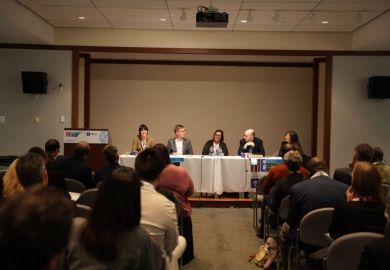US research output risks falling behind new science-based economies in Asia if it does not continue to invest and collaborate, warns a new study.
Authors said that the US “no longer stands alone” as a leading science and technology power, and hope the report will serve as a wake-up call.
Clarivate’s Institute for Scientific Information analysed data from the Web of Science to examine the impact of globalisation on US research, and its trajectory over the past 15 years.
The paper emphasises the importance of continued investment and collaboration to maintain the country’s position in the global research ecosystem.
US research investment, domestic research student numbers, and the output of research articles and reviews have not grown at the same rate as new science-based economies in Asia, nor the expanded European Union network, authors said.
The country, which has been a “dominant force” in global science since the end of the Second World War, now faces increased competition from rapidly developing nations such as Brazil, India, South Korea and China.
Jonathan Adams, chief scientist at the Institute for Scientific Information, said the US remains a leading science and technology power, but it “no longer stands alone”.
There is awareness of the problem within the country, but the consequences have not been fully appreciated, he told Times Higher Education.
“The US needs to wake up to the detail of what is happening,” he added.
The authors urged the country to acknowledge its shrinking domestic research capacity and work pragmatically with resourceful competitors to maintain its position.
Professor Adams said all countries see a shift from purely domestic research to international, but the US has lost greatest capacity in areas it sees as strategically important to innovation and to security.
“This is partly due to serious underfunding and mismanagement during the Trump administration, but longer term the relative underfunding of technology compared to the politically attractive funding directed to medically related areas has been a fatal flaw in the oversight of the US research system,” he added.
According to the authors, most growth in US research publication output is attributable to international collaboration, which has doubled for major traditional partners such as the UK and Germany and quadrupled with mainland China.
The report also confirms that the decline in domestic research capacity in engineering continues, warning that the research shift “appears to have happened without clear awareness in policy debates”.
The study also found that US research activity is unevenly spread across the country, and asked important questions about how past investment has prepared the US scientific enterprise to achieve its goals.
The physical sciences and technology were found to be the subjects where the US has the greatest degree of international collaboration and the smallest component of purely domestic research output.
Mainland China is its most frequent partner in technology research, as frequently as the UK and Germany in physical sciences, while collaborations with mainland China accounts for about 25 per cent of current US engineering output.
In 1981, mainland China claimed just a fraction of world engineering papers, but by 2019 that figure was close to 40 per cent.
“The US does and will continue to benefit from working with an acknowledged and resourceful competitor,” said the authors.
“It must do so with pragmatism and realism, not with either paranoia or wishful thinking.”
Register to continue
Why register?
- Registration is free and only takes a moment
- Once registered, you can read 3 articles a month
- Sign up for our newsletter
Subscribe
Or subscribe for unlimited access to:
- Unlimited access to news, views, insights & reviews
- Digital editions
- Digital access to THE’s university and college rankings analysis
Already registered or a current subscriber?







